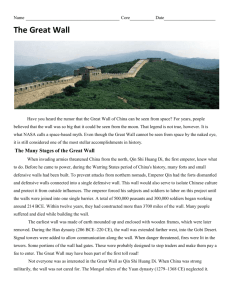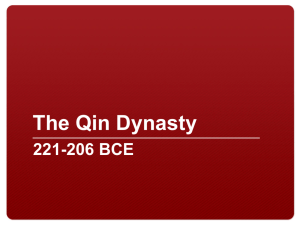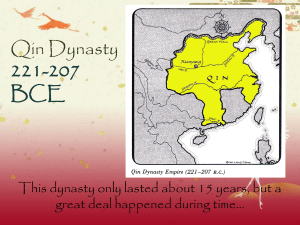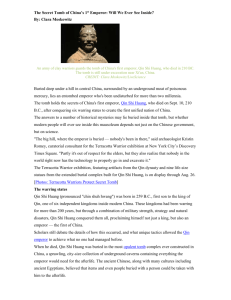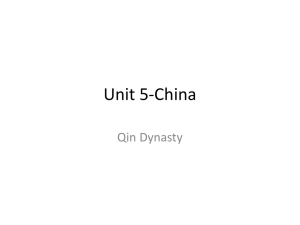AP World History
advertisement
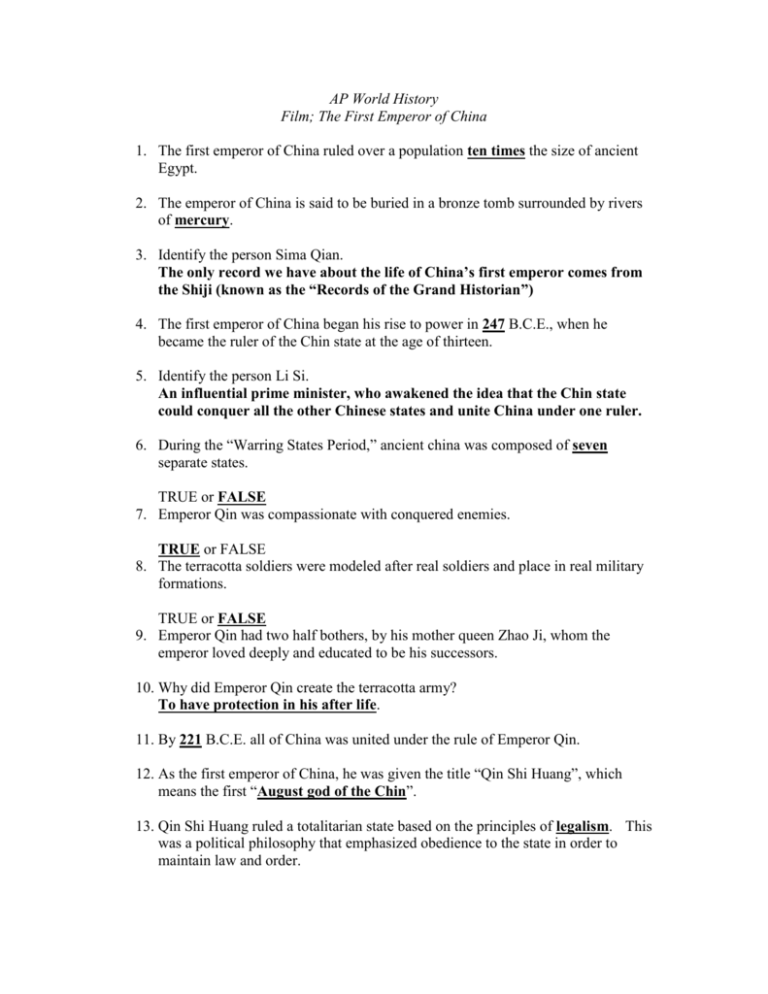
AP World History Film; The First Emperor of China 1. The first emperor of China ruled over a population ten times the size of ancient Egypt. 2. The emperor of China is said to be buried in a bronze tomb surrounded by rivers of mercury. 3. Identify the person Sima Qian. The only record we have about the life of China’s first emperor comes from the Shiji (known as the “Records of the Grand Historian”) 4. The first emperor of China began his rise to power in 247 B.C.E., when he became the ruler of the Chin state at the age of thirteen. 5. Identify the person Li Si. An influential prime minister, who awakened the idea that the Chin state could conquer all the other Chinese states and unite China under one ruler. 6. During the “Warring States Period,” ancient china was composed of seven separate states. TRUE or FALSE 7. Emperor Qin was compassionate with conquered enemies. TRUE or FALSE 8. The terracotta soldiers were modeled after real soldiers and place in real military formations. TRUE or FALSE 9. Emperor Qin had two half bothers, by his mother queen Zhao Ji, whom the emperor loved deeply and educated to be his successors. 10. Why did Emperor Qin create the terracotta army? To have protection in his after life. 11. By 221 B.C.E. all of China was united under the rule of Emperor Qin. 12. As the first emperor of China, he was given the title “Qin Shi Huang”, which means the first “August god of the Chin”. 13. Qin Shi Huang ruled a totalitarian state based on the principles of legalism. This was a political philosophy that emphasized obedience to the state in order to maintain law and order. 14. The Qin legal system encompassed every aspect of life, even a person’s private life. It stated that man was wicked and must be controlled by harsh laws 15. Why did Emperor Qin Shi Huang build the Great Wall? To protect northern China from attacks by nomadic tribes. 16. How many people were enslaved to build the Great Wall? Over one million. TRUE or FALSE 17. Because of the safety measures taken by Li Si, very few workers died during the Great Wall construction. 18. Later in his life, Qin Shi Huang feared death and desperately sought the fabled “elixir of life, which would supposedly allow him to live forever. A Chinese alchemist named Xu Fu, worked to help the emperor find immortality. 19. What did Chinese alchemist feed Emperor Qin Shi Huang believing it would extend his life? Mercury 20. Beginning in 213 B.C.E., at the instigation of Li Si and to suppress freedom of thought, Qin Shi Huang ordered most existing books to be burned with the exception of those on astrology, agriculture, medicine, divination, and the history the State of Chin. 21. According to the “Records of the Grand Historian,” the following year (212 BCE) Qin Shi Huang had some 460 scholars buried alive for owning forbidden books. 22. What effect did eating mercury have upon Emperor Qin Shin Huang? The mercury began to attack his nervous system and destroy his brain. He eventually went mad. 23. When did Emperor Qin Shin Huang die? 210 BCE TRUE or FALSE 24. Rebellion against the totalitarian government of Qin Shin Huang began shortly after his death. TRUE or FALSE 25. Emperor Qin Shin Huang had his concubines, tomb architects and designers buried alive in his tomb to guard against grave robbers.


